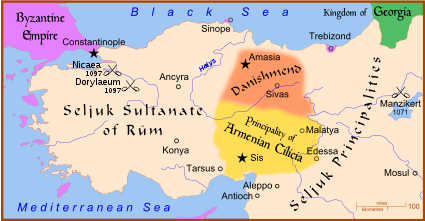Danishmend Gazi
| Danishmend Gazi | |
|---|---|
 Anatolia in 1097, before the Siege of Nicaea | |
| Died | 1104 |
| Persian language | |
Danishmend Gazi, full name Gümüştekin Danishmend Ahmed Gazi, Danishmend Taylu, or Malik Dānishmand Aḥmad Ghāzī (died 1104), was the founder of the beylik of Danishmends. After the Turkish advance into Anatolia that followed the Battle of Manzikert, his dynasty controlled the north-central regions in Anatolia.
Life
The defeat of the Byzantine army at the Battle of Manzikert allowed the Turks, including forces loyal to Danishmend Gazi, to occupy nearly all of Anatolia. Danishmend Gazi and his forces took as their lands central Anatolia, conquering the cities of Neocaesarea, Tokat, Sivas, and Euchaita.
During the First Crusade, he was directly on the path of the advancing crusaders. On the losing side at the Battle of Dorylaeum in 1097, he scored a success in capturing Bohemond I of Antioch in 1100. He continued campaigning, extending southwards and capturing Malatya (Melitene) in 1103 (see Battle of Melitene).
He was succeeded by his son Emir Gümüştekin Gazi.[1]
A tomb attributed to him is found in Niksar.[2]
Legend
Danishmend Gazi is the central figure in the Danishmendnâme ("Tale of Danishmend"), a 13th-century Turkish-language epic romance. In this allegory, events from the life of Danishmend Gazi are blended with the legendary exploits of the 8th-century Arab warrior Sayyid Battal Gazi and of the Persian hero of the early Abbasid period, Abu Muslim.
The legends that comprise Danishmendnâme were compiled from Turkish oral tradition for the first time by order of the Seljuk Sultan Kayqubad I, a century after Danishmend's death. The final form that reached our day is a compendium that was put together under the instructions of the early 15th century Ottoman sultan Murad II.
Dynasty and titles
Danishmend Gazi is sometimes also referred to by the title Melik meaning "King", which was actually bestowed upon his grandson in 1134 by the Abbasid Caliph of Baghdad and was sometimes used retrospectively by contemporaries and historiographers to refer also to Danishmend Gazi. The other title, Gazi, denotes a warrior.
There is also some confusion on his name and divergence among names used by scholars. He had the same name as his son, Gümüştekin. The father is often referred to shortly as Danishmend Gazi, while his son is called Emir Gazi, without mentioning the name Gümüştekin common to both. Furthermore, the Danishmend dynasty is also cited as having a family tie to the Seljuk dynasty although the explanations differ.
Notes
- ↑ Cawley, Charles, History: Medieval Lands Project: Turkish dynasties Check
|url=value (help), Medieval Lands database, Foundation for Medieval Genealogy, - ↑ (fact sheet) "Traditional Tomb of Danishmend Melik Ahmed Gazi" Check
|url=value (help). Archnet.
References
- (limited preview) Clifford Edmund Bosworth (2004). The New Islamic Dynasties: A Chronological and Genealogical Manual ISBN 0-7486-2137-7. Edinburgh University Press.
- Irene Melikoff (1960): Danishmendname La Geste de Melik Danishmend, translation and introduction to a Turkish epic of the 13th century
| New title | Melik of the Danishmends 1071–1104 |
Succeeded by Gazi Gümüshtigin |